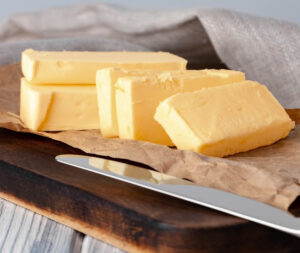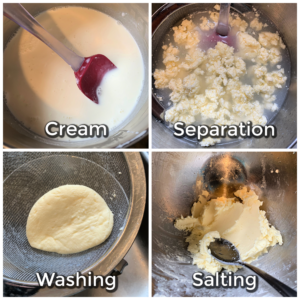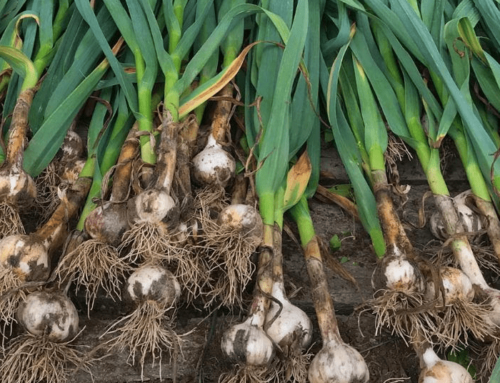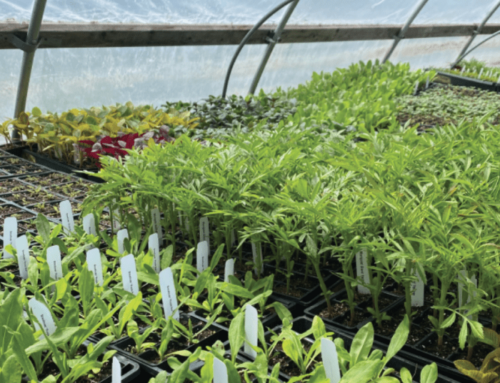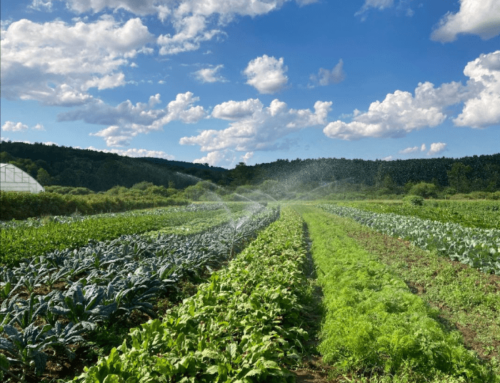By Christy Bassett, Homesteader at Barefoot All Natural Farm
Real, raw butter is just about impossible to source in Massachusetts unless you make it yourself. That’s because raw (unpasteurized) milk can only be sold unprocessed on the farm where it was collected straight from the cows. No cream, no butter, and no other fresh (unaged) processed dairy products can be sold raw in this state. Raw milk dairy products such as aged cheese are allowed to be sold if they are aged over 60 days, but since butter is a fresh product that must be used or preserved within that period before it goes rancid, aging is not really an option.
Luckily, Massachusetts has some excellent raw milk dairies throughout the Commonwealth where we can purchase fresh raw cow’s milk to process ourselves at home. Check out the list and map of the Massachusetts Raw Milk Network or The Organic Food Guide from NOFA/Mass to find a raw milk dairy farm near you.
One of my very favorite things to make with raw milk is butter. Not only is it something that we use every day in our house, but it’s a truly different product than store-bought butter. Using unpasteurized milk/cream to begin with, and making butter that is not heated above 110 degrees Fahrenheit at any time, means that all of the natural nutrients and enzymes are kept intact in the final product.
Our website shares more details about the benefits of raw milk:
Raw milk is the ultimate whole food. It contains many nutrients essential to human health, and comes complete with companion enzymes and amino acids necessary for the human body to make use of those nutrients.
Raw Milk Contains:
- High levels of calcium and other minerals, and the enzymes necessary to metabolize these minerals. Those enzymes are destroyed in the pasteurization process.
- An abundance of beneficial bacteria that can rebalance a digestive system unable to process many foods, and can restore the immune system. These good bacteria help produce and assimilate vitamins and minerals, fight off illnesses, and regulate bodily processes. Pasteurization destroys all bacteria in milk.
- Water- and fat-soluble vitamins, two-thirds or more of which are destroyed during pasteurization. Vitamins B6 and B12 are almost entirely destroyed during pasteurization. More than 50% of milk’s Vitamin C value is lost to pasteurization as well. Milk from grass-fed cows is higher in Vitamins A and D and has more omega-3 fatty acids (“the good fats”) and conjugated linoleic acid (CLA).
- A level of fat necessary for the body to absorb milk’s calcium and protein. Pasteurized reduced-fat or skim milk is an ineffective source of calcium.
- The enzymes phosphatase, essential for the absorption of calcium; lipase, which aids in the digestion of fats; and lactase, which helps with the digestion of lactose. Pasteurization, however, destroys all three of these enzymes.
- Amino acids, essential to the body’s ability to repair tissue, metabolize protein and generate energy. Pasteurization renders these acids useless.
The cool thing about making butter is that it only requires one ingredient: heavy cream. And, it’s super easy to make. But before you can get raw heavy cream, you must start with whole raw milk. Raw milk is typically not homogenized, meaning that the lighter fat/cream in whole milk will rise to the top of the container if left undisturbed for a few hours. This cream can then easily be poured or spooned off and separated by hand. Viola, heavy cream. The remaining skimmed milk can be used in other recipes or for drinking. Now that you have your needed ingredient, you’re ready to make raw butter.
Homemade Raw Butter
Ingredients:
- 2 cups heavy cream (from about 1 gallon whole raw cow’s milk)
- Salt, if desired
Directions:
- Allow cream to sit out of the refrigerator for a couple of hours, until it reaches about 60 degrees Fahrenheit.
- Add cream to a food processor or blender and mix at high speed until the milk clearly separates into butterfat solids and liquid buttermilk. This may take 45 seconds or 4-5 minutes, depending on the temperature and source of your cream and the speed that it’s agitated. Tips: If you stop mixing the cream part way through the process, you will have very thick cream, or whipped cream! Keep going to make butter. If you have been mixing for a very long time and your cream does not separate, it’s possible that your cream has soured and/or fermented too much and will not separate. Try again with fresher cream.
- Pour butterfat and buttermilk through a fine mesh strainer, cheesecloth or butter muslin to separate. Store the buttermilk in the refrigerator for another use.
- Place butterfat into a large bowl and cover with cold water. Use a spoon or spatula to work the water into (and out of) the butterfat. Drain water. Repeat “washing” the butter until the water runs clear.
- The washed butter is now ready for salting, if you like. Add ¼ tsp salt and mix into butter. Salting the butter adds flavor and extends shelf life.
- Work the butter into a shape that you like (round columns work well for wrapping in waxed paper or freezer paper) or place into a butter mold. Refrigerate until solid or freeze and enjoy later.
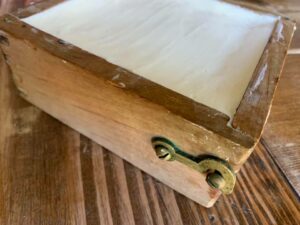
Our family’s antique wooden butter mold works well for shaping homemade butter.
Variations:
Cultured butter. Old fashioned butter was often “cultured” from natural bacteria in the environment. This creates a more complex flavor and allows the natural enzymes to begin breaking down the milk’s components and can become more digestible. Simply leaving your raw heavy cream out on the counter for 12-24 hours can allow it to ferment or “culture” naturally. The potential problem with this method is that you can never be quite sure what wild yeast or bacteria will multiply in the optimal growth environment that you’ve created for it.
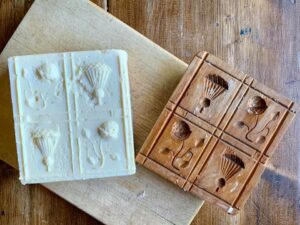
Antique wooden butter molds come in many different designs. This one features flower heads in a four part square. You can likely find one of these in your local antique shop.
To be more selective about the bacteria that is introduced and encouraged in your food, you can use a freeze-dried dairy culture powder. Mesophilic culture is commonly used for flavoring many fresh dairy products like butter, sour cream and cream cheese and can be sourced from a dairy supply company, like New England Cheese Making Supply Company. To culture your heavy cream with a specific commercial culture strain, heat the cream to 88 degrees Fahrenheit and sprinkle 1/8 teaspoon culture on the surface. Allow to be absorbed into the surface of the cream for 5 minutes, then stir to combine. Allow to culture for 12-24 hours. Cool cultured cream to 60 degrees and make butter as above.
Compound butter. Compound butter is simply butter with other flavorings mixed in. Before your butter cools and solidifies, try mixing in some herbs from your garden or spices from your cabinet. Some of my favorite compound butters are garlic and herb or chili jalapeño. Some people even make beautiful floral butter with edible flowers pressed into the butter.
If you’re interested in learning more about having a home dairy or processing milk into everyday food staples, check out my upcoming workshops at the 2021 virtual NOFA Summer Conference:
Keeping a Family Cow
For many homesteaders and small-scale farmers, a family cow is the pinnacle of self-sufficiency. Homegrown milk provides the basis for cream, butter, ice cream, buttermilk, cheese, whipped cream, yogurt and more while also maintaining your peace of mind, allowing you to know how the producing animal was fed, raised and handled.
Learn the basics of things that you should consider before buying a cow, including available breeds, space requirements, nutrition, health maintenance, breeding cycles, costs, time commitments, and more. Hear from two Massachusetts women about their experience owning family cows and find out for yourself if a dairy cow is right for you.
Making Mozzarella
Learn how to make fresh, melty, stretchy mozzarella cheese at home. If you’ve ever tried to make mozzarella before, but ended up with a gritty, flaky mess, this workshop will help you overcome your fear of trying again. Making fresh mozzarella can be tricky if you don’t know the proper ingredient measurements or progression of steps. But with a few simple guidelines, cheesemaking can be easy and fun. Be the hero of pizza night. Treat yourself and your family to the best homemade cheese, from the best local milk, you’ve ever tasted. Ingredients and kitchen equipment required.

